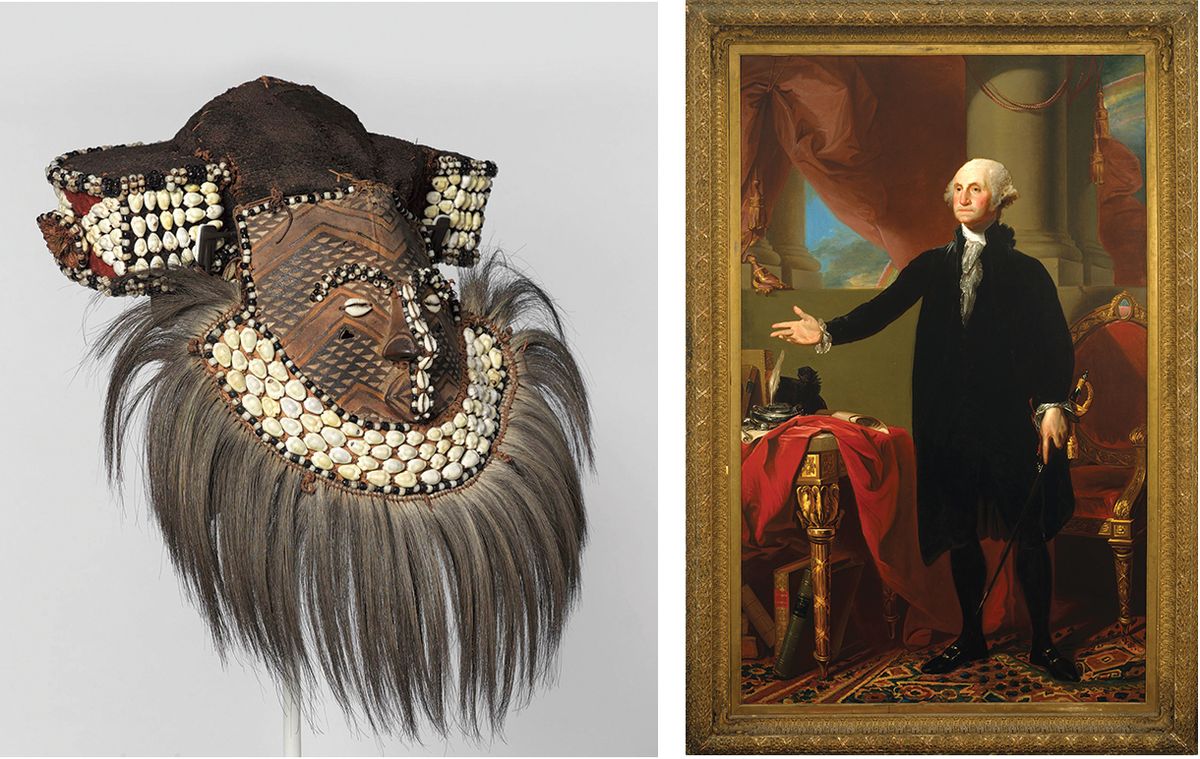It promises to be an unsettling sight: a Kuba mask crafted from rawhide, shells and monkey hair staring impassively at Gilbert Stuart’s stately 1796 painting of George Washington.
Yet as starkly different as they may be, the face-off of these two works of art at the Brooklyn Museum suggests that they share a common purpose, says Kristen Windmuller-Luna, the institution’s former curator of African arts and the organiser of African Arts–Global Conversations, which opens at the museum on 14 February. Both are idealised depictions of founding fathers, she notes, and chock full of iconography that would be familiar to people of the culture in which each originated.
For example, the mask depicting a onetime Kuba leader, dating from the late 19th or early 20th century, evokes wealth and status through its cowrie shells, which were a kind of currency in the Kuba kingdom of the central Congo, the curator says; the rainbow in the Washington portrait symbolises the peace and prosperity ushered in after the American Revolution.
The goal of this juxtaposition, one of many in the exhibition, is to challenge a traditional art historical narrative that has sidelined African art. By planting African works in museum galleries devoted to European art, art of the Americas, ancient Egyptian art and the arts of Asia, Windmuller-Luna proposes to generate discussion about shared themes and to reassert the importance of African art within the museum canon.
The curator recalls her undergraduate years at Yale University, when the only mention of African art in a textbook for an Art History 101 class was a generic footnote to a section about the genius of Picasso. “I’m envisioning this exhibition as a way to really fill in the blanks that are still present in museums and art history books,” says Windmuller-Luna, who recently assumed the post of curator of African arts at the Cleveland Museum of Art.
The works in the show, all drawn from the Brooklyn Museum’s permanent collection, range in date from 2,300BC to the present day. Indirectly the show also casts a lens on the collecting history of the museum, which began amassing African art at the turn of the 20th century and has one of the most important collections in that area in the United States. It was also the first museum in the country to display African objects as works of art–in a 1923 exhibition that bore a title that Windmuller-Luna says “we would never use now”: Primitive Negro Art, Chiefly From the Belgian Congo.
Each of the 20 African works in the current exhibition will be accompanied by a detailed label describing the art’s provenance, prodding visitors to consider the object’s historical purpose and the path that it took to enter the collection. Every grouping of an African work with art from another culture will be labeled with a theme that invites visitors to reflect on the works’ commonality, such as “Founding Fathers” in the case of the George Washington portrait and the Kuba mask.
An introductory gallery will serve as a snapshot of the broader exhibition, presenting examples of textbooks to demonstrate how sparsely African art has been represented in the art historical canon. It will also feature the first juxtapositions, exploring themes like “Feminisms” and “Idealised Portraits”.
“When you walk through the door, the first thing you’re going to see” are a large-scale abstract painting by the Ghanaian artist Atta Kwami from 2011 and one by the American artist Josef Albers” from 1957, Windmuller-Luna says of a pairing labeled “Multiple Modernisms”.
“Both artists happen to be teachers who were greatly influential to their students and are actually looking to non-Western sources to influence their particular style of abstract art,” she says. “Both force you to rethink the linear idea of Modernism that only came out of the Euro-American canon.”
One of the bolder groupings contrasts a processional cross fashioned in 14th-century Italy with contemporaneous crosses from Ethiopia. “You see a time when different kingdoms that are both Christian are sending embassies to each other and writing about each other’s religious art,” the curator says. She notes that Ethiopia converted to Christianity before Rome did, a fact that upends conventional thinking about the primacy of Western Christian art.
Windmuller-Luna particularly savours a 1945 painting by the African American artist Beauford Delaney depicting a Fang sculpture, a crow and fruit, paired with an 18th-to-19th-century Fang reliquary figure from Gabon. The face-off drives home how artists in the Harlem Renaissance looked to the African continent for inspiration, she says, resulting in “feedback loops” in which African American and European Modernists shared common sources. A book on display will be opened to the page on which Delaney discovered the Fang image that inspired him.
More broadly, the show anticipates an eventual reinstallation of the Brooklyn Museum’s African art galleries. For the first time, those galleries will be adjacent to their Egyptian counterparts, Windmuller-Luna says, negating the traditional barrier between pharaonic Egypt and sub-Saharan Africa. “I’m hoping that there will be an opportunity to mix,” she says, “and reinsert African art into the narrative.”
• African Arts–Global Conversations, Brooklyn Museum, 14 February–15 November


